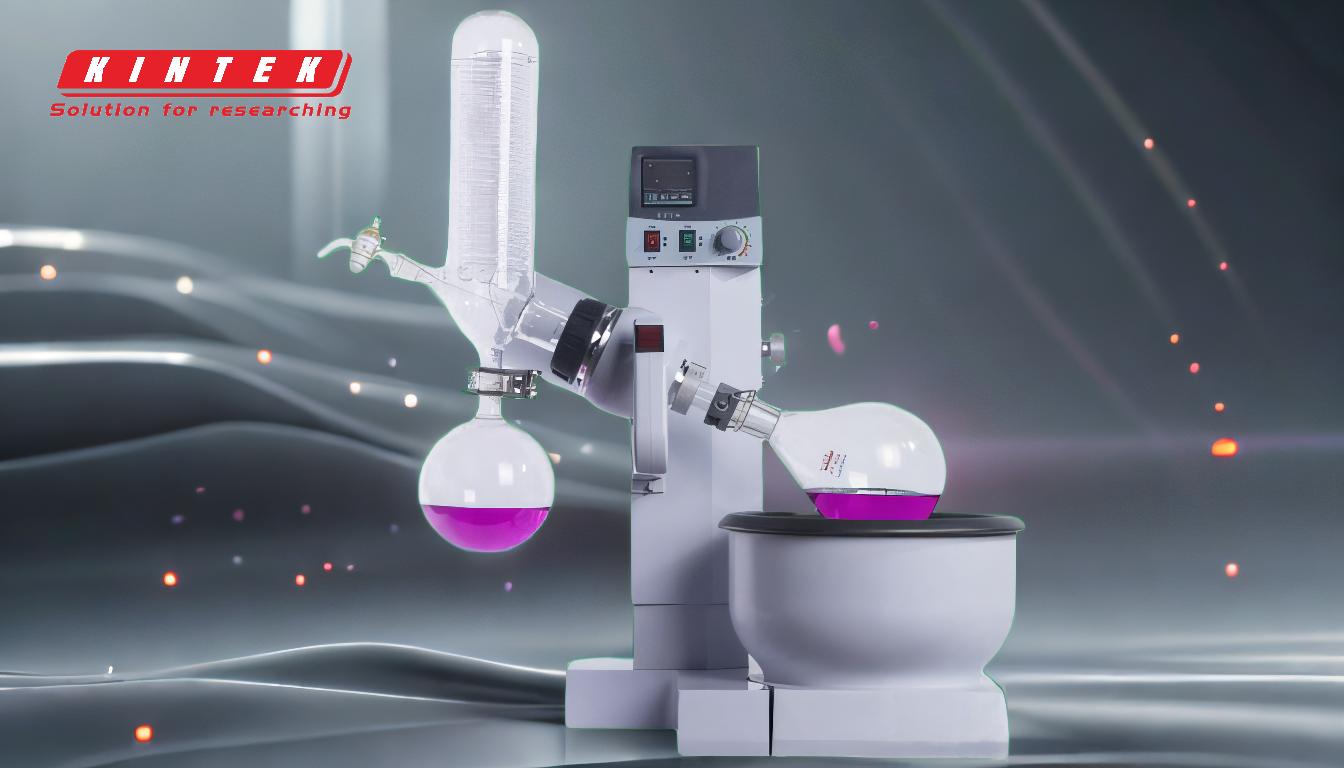Rotary evaporation is a laboratory technique used to gently and efficiently remove solvents from samples by reducing the volume of the solvent. This is achieved by distributing the solvent as a thin film across the interior of a vessel at elevated temperature and reduced pressure, which promotes the quick removal of excess solvent. The technique is widely used in various fields, including chemistry, biology, biotechnology, medicine, and environmental testing, for applications such as concentration, purification, solvent recovery, and sample preparation for further analysis. Rotary evaporators are particularly useful for separating solvents from organic, inorganic, and polymeric materials, especially when the desired compound has a lower boiling point than the solvent and does not form an azeotrope with it.
Key Points Explained:

-
Definition and Mechanism of Rotary Evaporation:
- Rotary evaporation is a process that reduces the volume of a solvent by distributing it as a thin film across the interior of a vessel.
- This is done under elevated temperature and reduced pressure, which accelerates the evaporation of the solvent.
- The technique is particularly effective for removing solvents from less volatile samples, such as organic, inorganic, and polymeric materials.
-
Applications of Rotary Evaporation:
- Concentration of Solutions and Suspensions: Rotary evaporation is commonly used to concentrate solutions by removing excess solvent, leaving behind a more concentrated sample.
- Crystallization or Recrystallization: The technique is used to induce crystallization or recrystallization by carefully controlling the evaporation process.
- Solvent Distillation and Recycling: Rotary evaporators are used to recover and recycle solvents, which is both cost-effective and environmentally friendly.
- Chemical Synthesis: In chemical synthesis, rotary evaporation is used to remove solvents from reaction mixtures, isolating the desired product.
- Purification of Samples: The technique is used to purify samples, such as plant extracts, essential oils, and other natural products.
- Distillation of Complex Mixtures: Rotary evaporation is employed to separate and purify compounds from complex mixtures, such as solvents, inorganic salts, and acids.
-
Fields of Use:
- Biology and Biotechnology: Rotary evaporation is used for the concentration and purification of biological samples, such as proteins and nucleic acids.
- Medicine and Pharmaceuticals: The technique is essential in drug development for the preparation and purification of active pharmaceutical ingredients (APIs).
- Environmental Testing: Rotary evaporation is used in environmental testing to concentrate and analyze samples for pollutants and contaminants.
- Food Safety Testing: The technique is employed in food safety testing to concentrate and purify samples for the detection of harmful substances.
- Chemical Laboratories: Rotary evaporators are a staple in chemical laboratories for the gentle and efficient removal of solvents from a wide range of samples.
-
Advantages of Rotary Evaporation:
- Efficiency: The technique allows for the rapid removal of solvents, making it a time-efficient method for sample preparation.
- Gentle Handling: Rotary evaporation is a gentle process that minimizes the risk of degrading or damaging sensitive samples.
- Versatility: The technique is applicable to a wide range of materials, including organic, inorganic, and polymeric substances.
- Solvent Recovery: Rotary evaporation facilitates the recovery and reuse of solvents, which is both economical and environmentally sustainable.
-
Key Components of a Rotary Evaporator:
- Rotating Flask: The sample is placed in a rotating flask, which increases the surface area of the solvent, promoting faster evaporation.
- Heating Bath: A heating bath is used to elevate the temperature of the solvent, further accelerating the evaporation process.
- Vacuum System: A vacuum system reduces the pressure inside the system, lowering the boiling point of the solvent and allowing for evaporation at lower temperatures.
- Condenser: The evaporated solvent is condensed back into a liquid form and collected in a separate flask.
- Collection Flask: The condensed solvent is collected in a flask, which can be reused or disposed of appropriately.
-
Considerations for Effective Rotary Evaporation:
- Boiling Point of Solvent: The technique is most effective when the desired compound has a lower boiling point than the solvent.
- Avoiding Azeotropes: Rotary evaporation is particularly efficient when the solvent and the desired compound do not form an azeotrope, which could complicate the separation process.
- Temperature Control: Careful control of the heating bath temperature is crucial to prevent overheating and potential degradation of the sample.
- Vacuum Pressure: Proper adjustment of the vacuum pressure is necessary to ensure efficient evaporation without causing the sample to boil too vigorously.
In summary, rotary evaporation is a versatile and efficient laboratory technique used for the concentration, purification, and separation of solvents from various materials. Its applications span across multiple scientific fields, making it an indispensable tool in modern laboratories. The technique's ability to gently and efficiently remove solvents, coupled with its versatility and solvent recovery capabilities, makes it a preferred method for many laboratory processes.
Summary Table:
| Aspect | Details |
|---|---|
| Definition | A technique to remove solvents by distributing them as a thin film under heat and reduced pressure. |
| Applications | Concentration, purification, solvent recovery, crystallization, and sample preparation. |
| Fields of Use | Chemistry, biology, biotechnology, medicine, environmental testing, and food safety. |
| Advantages | Efficient, gentle handling, versatile, and solvent recovery capabilities. |
| Key Components | Rotating flask, heating bath, vacuum system, condenser, and collection flask. |
| Considerations | Boiling point of solvent, avoiding azeotropes, temperature, and vacuum pressure control. |
Discover how rotary evaporation can streamline your lab processes—contact us today for expert advice!











